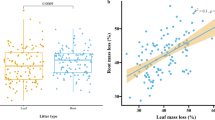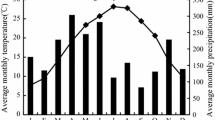Abstract
Litter production, litter standing crop, and potential nutrient return via litterfall to soil were studied during a 4-year period (January 2004–December 2007) in a Chinese fir (Cunninghamia lanceolata (Lamb.) Hook) plantation and a secondary broadleaved forest in Hunan Province in subtropical China. Mean annual litterfall in the sampling sites varied from 358 g m−2 in the pure plantation to 669 g m−2 in the secondary broadleaved forest. Total litterfall followed a bimodal distribution pattern for both forests. Amount of litterfall was also related to the air temperature in both forests. During the period under this study, annual variation in the total litterfall in the pure plantation was significantly higher than that in the secondary broadleaved forest. Litterfall was markedly seasonal in the both forests. Leaf proportions of litterfall in the pure plantation and secondary broadleaved forest were 58.1 and 61.7%, respectively. Total potential nutrient returns to the soil through litterfall in the pure plantation were only 46.2% of those in the secondary broadleaved forest. Total litter standing crop was 913 and 807 g m−2 in the pure plantation and secondary broadleaved forest, respectively. Our results confirm that conversion from a secondary broadleaved forest into a pure coniferous plantation changes the functioning of the litter system.



Similar content being viewed by others
References
Arunachalam A, Arunachalam K, Pandey HN, Tripathi RS (1998) Fine litterfall and nutrient dynamics during forest regrowth in the humid subtropics of north-eastern India. For Ecol Manage 110:209–210
Bernhard-Reversat F (1993) Dynamics of litter and organic matter at the soil-litter interface in fast-growing tree plantations on sandy ferrallitic soils (Congo). Acta Ecol 14:179–195
Chen C, Wang S (2004) Ecology of mixed plantation forest. Science Press, Bei**g, p 3
Chen CY, Zhang JW, Zhou CL, Zheng HY (1990) Researches on improving the quality of forest land and the productivity of artificial Cunninghamia lanceolata stands. J Appl Ecol 1:97–106
Deng C, Hou J, Li S, Zhao H, Fu J (1993) Study on forest litter in Ailao Mountain, North China. Acta Phytoecol Geobot Sin 17:364–370
Deng S, Liao L, Wang S, Gao H (2000) Bioproductivity of Castanopsis hystrix-Cyclobalanopsis glauca-Machilus Pauhoi community in Huitong, Hunan. Chin J Appl Ecol 1:651–654
Fang X, Tian D, **ang W, Lei P (2005) Litter production and carbon release ratios in the litter decomposition process of litter in Chinese fir plantations. J Center South For Univer 25:12–16
FAO (2006) Global forest resource assessment 2005. Food and Agricultural Organization of the United Nations, Rome
Goma-Tchimbakala J, Bernhard-Reversat F (2006) Comparison of litter dynamics in three plantations of an indigenous timber-tree species (Terminalia superba) and a natural tropical forest in Mayombe, Congo. For Ecol Manage 229:304–313
Haggar JP, Ewel JJ (1997) Primary productivity and resource portioning in model tropical ecosystems. Ecology 78:1211–1221
Hoorens B, Aerts R, Stroetenga M (2003) Does initial litter chemistry explain litter mixture effects on decomposition. Oecologia 137:578–586
Jackson JF (1978) Seasonality of flowering and leaf fall in a Brazilian subtropical lower montane moist forest. Biotropica 10:38–42
Jones JB, Case VW (1990) Sampling, handling, and analyzing plant tissue samples. In: Westerman RL (ed) Soil testing and plant analysis. Soil Science Society of America, Inc., Madison, WI, pp 390–428
Jorgensen JR, Well CG, Metz LJ (1975) The nutrient cycle. Key to continuous forest production. J For 73:400–403
Kelty MJ (2006) The role of species mixtures in plantation forestry. For Ecol Manage 233:195–204
Lian Y, Zhang Q (1998) Conversion of a natural broad-leafed evergreen forest into pure and mixed plantation forests in a subtropical area: effects on nutrient cycling. Can J For Res 28:1518–1529
Liao L, Yang Y, Wang S, Gao H (1999) Distribution, decomposition and nutrient return of the fine root in pure Cunninghamia lanceolata, Michelia macclurei and the mixed plantations. Acta Ecol Sin 19:342–346
Liao L, Wang S, Chen C (2000) Dynamics of litterfall in the mixed plantation of Cunninghamia lanceolata and Michelia macclurei: a ten-year’s observation. Chin J Appl Ecol 11(Supp):131–136
Lisanework N, Michelsen A (1994) Litterfall and nutrient release by decomposition in three plantations compared with a natural forest in the Ethiopian highland. For Ecol Manage 65:149–164
Meentmeyer V (1982) World patterns and amounts of terrestrial plant litter production. Bioscience 32:125–128
Mlambo D, Nyathi P (2008) Litterfall and nutrient return in a semi-arid southern African savanna woodland dominated by Colophospermum mopane. Plant Ecol 196:101–110
Moore TC (1980) Biochemistry and physiology of plant hormones. Narosa Publishing House and Springer Verlag, New Delhi pp. 274
Olsen SR, Sommers LE (1982) Phosphorus. In: Page AL, Miller RH, Keeney DR (eds) Methods of soil analysis, part 2. Agronomy Society of America and Soil Science Society of America, Madison, WI, pp 403–430
Pandey RR, Sharma G, Tripathi SK, Singh AK (2007) Litterfall, litter decomposition and nutrient dynamics in a subtropical natural oak forest and managed plantation in northeastern India. For Ecol Manage 240:96–104
Parrotta JA (1999) Productivity, nutrient cycling, and succession in single- and mixed-species plantation of Casuarina equisetifolia, Eucalyptus robusta, and Leucaena leucocephala in Puerto Rico. For Ecol Mnaage 124:45–77
Polyakova O, Billor N (2007) Impact of deciduous tree species on litterfall quality, decomposition rates and nutrient circulation in pine stands. For Ecol Manage 253:11–18
Schere-Lorenzen M, Bonilla JL, Potvin C (2007) Tree species richness affects litter production and decomposition rates in a tropical biodiversity experiment. Oikos 116:2108–2124
Spain AV (1984) Litterfall and the standing crop of litter in three topical Australian rainforests. J Ecol 72:947–961
Stohlgren TJ (1988) Litter dynamics in two Sierran mixed conifer forests. I. Litterfall and decomposition rates. Can J For Res 18:1127–1135
Sundarapandian SM, Swamy PS (1999) Litter production and leaf-litter decomposition of selected tree species in tropical forests at Kodayar in the Western Ghats, India. For Ecol Manage 123:231–244
Taylor BR, Parkinson D, Parsons WFJ (1989) Nitrogen and lignin content as predictors of litter decay rates: a microcosm test. Ecology 70:97–104
Trofymow JA, Moore TR, Titus B, Prescott C, Morrison I, Siltanen M, Smith S, Fyles J, Wein R, Camiré C, Duschene L, Kozak L, Kranabetter M, Visser S (2002) Rates of litter decomposition over 6 years in Canadian forests: influence of litter quality and climate. Can J For Res 32:789–804
Wang Q, Wang S (2007) Soil organic matter under different forest types in southern China. Geoderma 142:349–356
Wang Q, Wang S, Feng Z (2006) Comparison of active soil organic carbon pool between Chinese fir plantations and evergreen broadleaved forests. J Bei**g For Univ 28:1–6
Wang Q, Wang S, Fan B, Yu X (2007) Litter production, leaf litter decomposition and nutrient return in Cunninghamia lanceolata plantations in south China: effect of planting conifers with broadleaved species. Plant Soil 297:201–211
Wang Q, Wang S, Huang Y (2008) Comparison of litterfall, litter decomposition and nutrient return in a monoculture Cunninghamia lanceolata and a mixed stand in southern China. For Ecol Manage 255:1210–1218
Wu C, Hong W (2002) Dynamics of litterfall in Cunninghamia lanceolata forest using wave-type series analysis. J Trop Subtrop Bot 10:201–206
**ao C, Sang W, Wang R (2008) Fine root dynamics and turnover rate in an Asia white birch forest of Donglingshan Mountain, China. For Ecol Manage 255:765–773
Xu QF, Xu JM (2003) Changes in soil carbon pools induced by substitution of plantation for native forest. Pedosphere 13:271–278
Yang Y, Guo J, Chen G, **e J, Cai L, Lin P (2004) Litterfall, nutrient return, and leaf-litter decomposition in four plantations compared with a natural forest in subtropical China. Ann For Sci 61:465–476
Yang Y, Guo J, Lin P, He Z, Chen G (2005) Carbon and nutrient pools of coarse woody debris in a natural forest and plantation in subtropical China. Sci Sil Sin 41:7–11
Zhang J, Liao L, Li J, Su Y (1993) Litter dynamics of Pinus massoniana and Michelia macclurei mixed forest and its effect on soil nutrients. Chin J Appl Ecol 4:359–363
Acknowledgments
This research was supported by the National Natural Science Foundation of China (30590381-07) and the Chinese Academy of Science Program (No. KZCX2-YW-405). We sincerely appreciate the efforts of the two anonymous reviewers who provided comments for the improvement of our manuscript. We are also grateful to the Huitong National Research Station of Forest Ecosystem for providing the study sites and laboratory facilities, and to **uyong Zhang for his assistance during sampling.
Author information
Authors and Affiliations
Corresponding author
Electronic supplementary material
Below is the link to the electronic supplementary material.
Rights and permissions
About this article
Cite this article
Wang, Q., Wang, S., Xu, G. et al. Conversion of secondary broadleaved forest into Chinese fir plantation alters litter production and potential nutrient returns. Plant Ecol 209, 269–278 (2010). https://doi.org/10.1007/s11258-010-9719-8
Received:
Accepted:
Published:
Issue Date:
DOI: https://doi.org/10.1007/s11258-010-9719-8




